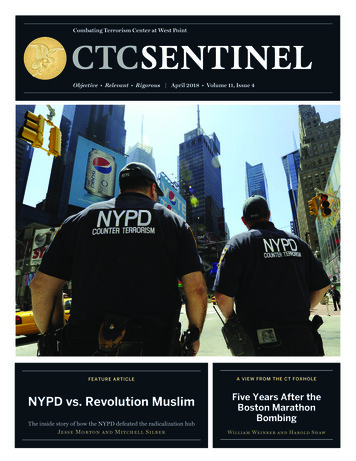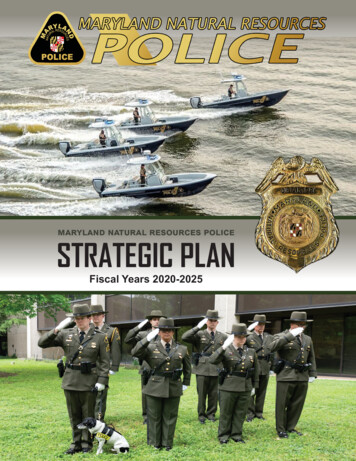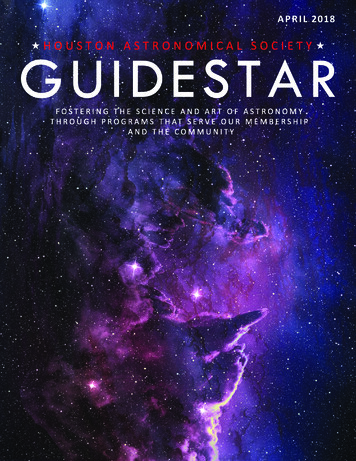
Transcription
Combating Terrorism Center at West PointObjective Relevant Rigorous April 2018 Volume 11, Issue 4FEATURE ARTICLENYPD vs. Revolution MuslimThe inside story of how the NYPD defeated the radicalization hubJesse Morton and Mitchell SilberA VIEW FROM THE CT FOXHOLEFive Years After theBoston MarathonBombingWilliam Weinreb and Harold Shaw
FEATURE ARTICLE1NYPD vs. Revolution Muslim: The Inside Story of the Defeat of a LocalRadicalization HubJesse Morton and Mitchell SilberEditor in ChiefPaul CruickshankManaging EditorKristina HummelINTERVIEW8A View from the CT Foxhole: Five Years After the Boston Marathon BombingNicholas TallantEDITORIAL BOARDColonel Suzanne Nielsen, Ph.D.Department HeadANALYSIS15 The Islamic State's Lingering Legacy among Young Men from the Mosul AreaScott Atran, Hoshang Waziri, Ángel Gómez, Hammad Sheikh, LucíaLópez-Rodríguez, Charles Rogan, and Richard Davis23 Challenging the ISK Brand in Afghanistan-Pakistan: Rivalries and DividedLoyaltiesAmira Jadoon, Nakissa Jahanbani, and Charmaine WillisDept. of Social Sciences (West Point)Lieutenant Colonel Bryan Price, Ph.D.Director, CTCBrian DodwellDeputy Director, CTC30 The British Hacker Who Became the Islamic State's Chief Terror CyberCoach: A Profile of Junaid HussainNafees HamidCONTACTCombating Terrorism CenterU.S. Military AcademyBetween 2006 and 2012, two men working on opposite sides of the struggle between global jihadis and the United States faced off in New York City.Jesse Morton was the founder of Revolution Muslim, a group that proselytized—online and on New York City streets—on behalf of al-Qa ida. Mitchell Silber led efforts totrack the terrorist threat facing the city as the director of intelligence analysis for the NYPD. Afterserving a prison sentence for terrorist activity, Morton now works to counter violent extremism. Inour feature article, they tell the inside story of the rise of Revolution Muslim and how the NYPD, byusing undercover officers and other methods, put the most dangerous homegrown jihadi supportgroup to emerge on U.S. soil since 9/11 out of business. As the Islamic State morphs into a ‘virtualcaliphate,’ their case study provides lessons for current and future counterterrorism investigations.Five years ago this month, terror came to Boston, and Boston stood strong. Nicholas Tallant interviews William Weinreb and Harold Shaw on the lessons learned. Weinreb stepped down as ActingUnited States Attorney for the District of Massachusetts in January 2018. He was the lead prosecutorof the 2015 investigation and trial of Boston Marathon bomber Dzhokhar Tsarnaev. Shaw has servedas the Special Agent in Charge of the Federal Bureau of Investigation’s Boston Division since 2015.Between July and October 2017, a team of researchers conducted field interviews with youngSunni Arab men coming out from under Islamic State rule in the Mosul area. The resulting study byScott Atran, Hoshang Waziri, Ángel Gómez, Hammad Sheikh, Lucía López-Rodríguez, Charles Rogan, and Richard Davis found that “the Islamic State may have lost its ‘caliphate,’ but not necessarilythe allegiance of supporters of both a Sunni Arab homeland and governance by sharia law.” AmiraJadoon, Nakissa Jahanbani, and Charmaine Willis examine the evolving rivalry between the IslamicState and other jihadi groups in the Afghanistan-Pakistan region. Nafees Hamid profiles Junaid Hussain, a hacker from the United Kingdom, who until his death in August 2015 was the Islamic State’smost prolific English-language social media propagandist and terror ‘cybercoach.’Paul Cruickshank, Editor in Chief607 Cullum Road, Lincoln HallWest Point, NY 10996Phone: (845) 938-8495Email: sentinel@usma.eduWeb: www.ctc.usma.edu/sentinel/SUBMISSIONSThe CTC Sentinel welcomes submissions.Please contact us at sentinel@usma.edu.The views expressed in this report arethose of the authors and not of the U.S.Military Academy, the Department of theArmy, or any other agency of the U.S.Government.Cover: New York City Police DepartmentCounter Terrorism Unit officers patrol inTimes Square on May 5, 2010. (Timothy A.Clary/AFP/Getty Images)
A P R I L 2 01 8CTC SENTINEL1NYPD vs. Revolution Muslim: The Inside Storyof the Defeat of a Local Radicalization HubBy Jesse Morton and Mitchell SilberBetween 2006 and 2012, two men working on oppositesides of the struggle between global jihadis and the UnitedStates faced off in New York City. One was the founder ofRevolution Muslim, a group which proselytized—onlineand on New York streets—on behalf of al-Qa ida. Theother led efforts to track the terrorist threat facing thecity. Here, they tell the inside story of the rise of RevolutionMuslim and how the NYPD, by using undercover officersand other methods, put the most dangerous homegrownjihadi support group to emerge on U.S. soil since 9/11out of business. As the Islamic State adjusts to its loss ofterritory, this case study provides lessons for current andfuture counterterrorism investigations.The Revolution ended on a dusty street outside amosque in Casablanca, Morocco. The sun was settingin late May 2011 when Moroccan police cleared thestreets and stopped and arrested Younus AbdullahMuhammad (aka Jesse Morton, the co-author of thisarticle) as he was on his way home to his wife and two young sons.The officers told the man who had been one of the most prolific recruiters for al-Qa ida in the United States, “You have a problem. Itis not with Morocco but with America. You are wanted as Americanal-Qa ida, and we’re sending you home.”1 A few months earlier, ajury in the Eastern District of Virginia had indicted Younus Abdullah Muhammad for incitement to terrorism, and the United Stateshad requested his extradition from Morocco.2The indictment of Younus Abdullah Muhammad capped a sixyear international investigation that began in New York City buttouched four continents. It required the deployment of four deepundercover officers, a team of detectives, intelligence analysts, andconfidential informants as well as close partnerships with multiplefederal agencies and international allies.3 It was an investigationthat co-author Mitchell Silber supervised for the New York CityPolice Department Intelligence Division.The disruption and destruction of the Revolution Muslim terrornetwork was of critical importance. Through its violent ideologyJesse Morton was the founder of Revolution Muslim and a formerjihadi extremist. After serving a prison sentence for terrorist activity he is now an executive officer at Parallel Networks, a UnitedStates based nonprofit dedicated to combating violent extremism.Mitchell D. Silber is the former Director of Intelligence Analysis atthe New York City Police Department and is currently an adjunctprofessor at Columbia University’s graduate School for Public andInternational Affairs.and prowess in radicalization and recruitment in the West, thenetwork was connected to almost 20 American and British terrorists, with plots that included a September 2011 attempt to fly aremote-controlled plane strapped with explosives into the Pentagon, a March 2010 plan to kill a Swedish cartoonist who satirizedthe Prophet Muhammad by Colleen LaRose (aka Jihad Jane), theMay 2010 stabbing of a British member of Parliament, a Christmasbomb plot in 2010 against the London Stock Exchange, the January2009 targeting of the Chabad-Lubuvitch headquarters in Brooklyn,death threats against the creators of South Park in April 2010, and aNovember 2011 lone-actor bomb plot in New York City.4 One member of the Revolution Muslim network was killed in a drone strikein Yemen, where he had joined al-Qa ida in the Arabian Peninsula(AQAP). Several attempted to leave the United States to fight foral-Qa ida Core and al-Shabaab between 2007 and 2011, and somejoined the Islamic State in Iraq and Syria during 2013 and 2014.5 Allin all, there were at least 15 plots, arrests, or kinetic military actionsrelated to members of the Revolution Muslim network worldwide.6And at the center of Revolution Muslim was its founder andleader, Younus Abdullah Muhammed, aka Jesse Morton. As U.S.Attorney Neil MacBride noted in 2012, “Jesse Morton operatedRevolution Muslim to radicalize those who saw and heard his materials online and to incite them to engage in violence against thosethey believed to be enemies of Islam. We may never know all ofthose who were inspired to engage in terrorism because of Revolution Muslim, but the string of recent terrorism cases with tiesto Morton’s organization demonstrates the threat it posed to ournational security.”7Revolution Muslim was a virtual terrorist group before the term‘virtual caliphate’ was used by some to describe the Islamic Statefollowing its loss of territory in Iraq and Syria. As a result, analyzingthe history, operations, and means employed by the New York CityPolice Department (NYPD) in thwarting Revolution Muslim offersessential insights in understanding the challenges now presentedby the Islamic State.The NYPD Intelligence Division’s effort to disrupt, dismantle,and destroy the Revolution Muslim network and radicalization hubwas multi-faceted and required a sustained effort over more thansix years. It is useful to examine this effort by breaking it down intofive different phases: 1) Identification phase—detecting the threat/network; 2) Investigation and Penetration phase—beginning theinvestigation; 3) Intelligence Collection and Analysis phase—understanding the threat; 4) Crushing the Network phase—arrestingand prosecuting; and 5) Loose Ends phase—pursuing members onthe periphery of the network who later activated. At a time whensome believe the Islamic State appears to be morphing into a virtualcaliphate, it is the authors’ hope that this analysis provides lessonsfor future counterterrorism efforts.
2CTC SENTINEL1. Identification Phase: Detecting the Threat/Network through Digital HUMINTStarting from scratch in late 2002 with little experience or knowhow, the NYPD created the first “cyber intelligence unit” in anymetropolitan police force anywhere in the world. The IntelligenceDivision had learned quickly that the internet was becoming animportant tool of terrorist organizations. Al-Qa ida and its affiliates were beginning to communicate their ideology digitally, andthese messages were translated into English and shared via onlinediscussion boards. The internet was rapidly becoming a source ofradicalization, a place where already radicalized individuals aroundthe world could communicate securely with one another in online“echo chambers,”a forming “virtual” jihadi clusters. The internet hadalso become a threatening source of information on bomb-makingmaterial, explosive devices of all kinds, and manufacturing techniques, thus obviating the need to travel to locations like Afghanistan for this type of training.As a result, over time, the NYPD developed a cadre of detectives,fluent in a wide range of languages from Arabic to Urdu, who spenttheir days online looking for postings and websites that promotedterrorism. Because of their diverse ethnic backgrounds and nativelanguage capabilities, they could interact under ‘legends’b or fakeidentities and communicate with aspiring terrorists in a convincingway, even in private chatrooms like Telegram predecessor Paltalk.These “digital undercover officers” would identify persons of concern, and if investigative thresholds were met, an inquiry would begin involving the digital undercover, a civilian intelligence analyst,and a detective working as a team on the case.It was one of these teams that in December 2007 detected thesplit within a New York City-based Islamist organization, the Islamic Thinkers Society (ITS), which gave rise to Revolution Muslim.Younus Abdullah Muhammed along with Youssef al-Khattab splitoff from ITS to create the new group because they felt the IslamicThinkers Group was not extreme or active enough.8The NYPD had been closely monitoring ITS activities both online and in New York City. ITS was essentially the U.S. branch of asalafi-jihadi support group called al-Muhajiroun, which had beenbanned by the British government in the wake of the July 7, 2005,London bombings.9 cLargely unwelcome in New York City mosques, ITS organizedprovocative events, like the desecration of the American flag, inneighborhoods populated by a Muslim majority as well as in publicaM O RT O N / S I L B E RA P R I L 2 01 8This phenomenon was discussed in the NYPD’s 2007 monograph“Radicalization in the West: The Homegrown Threat,” p. 37. The echochamber is “virtual networks of like-minded individuals around theworld who reinforce the individual’s beliefs and commitment and furtherlegitimize them.”bA legend is a spy or undercover officer’s claimed background or biography.cAl-Muhajiroun (The Emigrants) was designated a terrorist salafi-jihadiorganization in the wake of the July 7, 2005, London underground and busattack and was linked to international terrorism, homophobia, and antiSemitism. The group operated in the United Kingdom from January 14,1986, until the British government announced an intended ban in August2005. The group became notorious for its September 2002 conference,“The Magnificent 19,” praising the 9/11 attacks.spaces such as Times Square.d The group operated with impunityin the United States and was perceived as an extreme fringe group.As an NYPD intelligence report noted at the time, the split between ITS and Revolution Muslim concerned the NYPD, whichcorrectly understood the fracture as a faultline that could resultin an even more extreme splinter organization. NYPD IntelligenceDivision analysts noticed at the time that ITS had begun “to fragment into a handful of small, overlapping groups, most of whom[were] distancing themselves from ITS leadership.”10 Furthermore,the NYPD team assessed that “former members of ITS who are distancing themselves [from the group] are inherently more volatileand pose a greater threat to security.”112. Investigation and Penetration Phase: Beginningthe InvestigationWhen it came time to open a new investigation, legal oversight andapproval was crucial. The NYPD is bound by the U.S. Constitutionand Federal Court Guidelines called the Handschu Guidelines;these provide the overarching boundaries within which the NYPDand Intelligence Division leadership is obligated to work. Legalstaff, including the Deputy Commissioner of Legal Matters, wererequired to provide final approval to open any new investigationregarding “political activity” when it was determined that a groupor individual’s activity crossed the legal threshold.As Revolution Muslim finalized its split with ITS, the NYPDopened up an active investigation into the group because of the“reasonable suspicion of links to unlawful activity,” as per the Handschu regulations.12 Once this occurred in early 2008, the NYPDcould begin the process of inserting a deep undercover officer orconfidential informant into Revolution Muslim. One NYPD undercover officer had already penetrated ITS by this time. ITS andRevolution Muslim were two of the highest profile investigationswithin the NYPD Intelligence Division between 2005 and 2011.13The NYPD Intelligence Division Undercover (UC) program,whose origins date back to Police Commissioner Theodore Roosevelt and the fight against the Black Hand crime syndicate in 1905,14is unique in the world. As previously noted, it consists of youngofficers—“typically 22-26 years old—almost all born abroad or firstgeneration, all U.S. citizens, and all with native fluency in a varietyof languages. Since 9/11, the cadre has consisted of men and womenwith roots in over a dozen countries, mostly South Asia, the Middle East, and North Africa These rookies enter the Departmentvia the Intelligence Division rather than the Police Academy. Handchosen, they [are] smart, highly motivated, and fully understandingof the complexity of what they [are] about to do as professionals.”15As UCs, they never enter an NYPD facility. They go through anintense six-month training program run by the undercover unit it-dOn June 8, 2005, the ITS publicly desecrated and ripped up an Americanflag on the street in New York City during a rally on 74th Street and 37thAvenue in Queens. This event, which its members called “Operation:Desecrate American Flag,” was videotaped by the Islamic Thinkers Societyand can be seen on the internet. The group’s five-minute video begins witha man saying in English, “Just to show where our loyalty belongs to, you seethis flag here? It’s going to go on the floor [sic]. And to us, our loyalty doesnot belong to this flag, our loyalty belongs to Allah.” Another speaker refersto the mandate for “Islam to dominate over all other religions, to dominatethe world, even though the non-Muslims may hate it.” “Islamic ThinkersSociety desecrates flag,” The Investigative Project on Terrorism, June 8,2005.
A P R I L 2 01 8CTC SENTINEL3A screen capture from a video posted to YouTube by Revolution Muslim showing Younus Abdullah Muhammad(aka Jesse Morton) preaching on 43rd and Broadway in New York City on May 1, 2010.self, usually in hotel rooms or locations far from New York City. Thetraining class consists of one student at a time, and instructors areoften former UCs who understand the professional and personalissues that might arise when a person lives full-time as someoneother than him/herself. The pressure on the UCs, their handlers,and their managers is intense as the stakes are high—to the UC andthe investigation they are involved in.16The UCs are a cadre of officers who have blended naturally withthe persons, clusters, and organizations under investigation. Theywere critical in thwarting a number of cases, including one of the15 Revolution Muslim-linked cases called the “Arabian Knightz.”In this case, Mohamed Alessa and Carlos Almonte, both of NewJersey, were arrested in June 2010 on their way to Somalia to joinal-Shabaab, a terrorist organization to kill individuals whose beliefs and practices did not accord with their ideology. Both Alessaand Almonte were associates of Younus Abdullah Muhammad andmembers of the Revolution Muslim organization.17As Almonte and Alessa’s plan to join al-Shabaab came together, a remarkable 23-year-old NYPD undercover officer of Egyptianbackground was invited to join them after he spent months engaging with them. Subsequently, a joint NYPD-New Jersey JointTerrorism Task Force operation was conducted. After the arrest ofAlmonte and Alessa at JFK Airport while on their way to Somaliavia Egypt, the case became public. As per Intelligence Division policy, the UC’s parents and his girlfriend (later his wife) had no ideahe had been living a separate life as an NYPD Intelligence DivisionUC for the previous four years.18Similarly, the NYPD ran an operation that required cooperation from both the U.S. ambassador in Pakistan and the Pakistanigovernment to disrupt a New York City member of the RevolutionMuslim network from joining al-Qa ida in the Afghanistan-Pakistan region. When Staten Island resident Abdel Hameed Shehadeh traveled to Pakistan in 2008 for jihadi training he was turnedback at the airport by Pakistani authorities based on intelligenceprovided by a different NYPD undercover officer. Shehadeh hadvolunteered his plan to the undercover officer who was part of theShehadeh cluster investigation in a car less than 24 hours before hisscheduled departure to Islamabad.19 eAnother backbone of the Intelligence Division operations involved using confidential informants (CIs) to get close to thosepersons, clusters, or organizations under investigation. Since itspost-9/11 restart, the Intelligence Division understood and stayedfirmly committed to the policy of avoiding any action that might beinterpreted as entrapment. Division management at all levels knewthis would be a first line of defense in prosecution of a terrorist case.Entrapment was indeed the initial defense strategy in the caseagainst another of the 15 Revolution Muslim-linked cases, JosePimental of New York City, a self-radicalized internet disciple ofAQAP’s Anwar al-Awlaki and Revolution Muslim.20 According tothe statement of facts when he ultimately pleaded guilty, Pimentalhad been in contact with Younus Abdullah Muhammed, volunteering to him that he was a big fan of Revolution Muslim.21Pimental was arrested on the evening of November 19, 2011 bymembers of the NYPD bomb squad as he finalized the constructionof three homemade explosive devices in an apartment in Washington Heights.22 His plan had been “to assassinate members of theU.S. military returning from active duty in Afghanistan.”23The multi-year investigation of Pimental by the Intelligencee“According to court filings and the evidence introduced at trial, in early2008 Shehadeh devised a plan to travel to the Federally AdministeredTribal Areas of Pakistan in order join al-Qa ida or the Taliban. In furtheranceof his plan, on June 13, 2008, Shehadeh flew on a one-way airline ticketfrom John F. Kennedy International Airport to Islamabad, Pakistan. AfterPakistani officials denied him entry, Shehadeh told investigators from theFBI’s Joint Terrorism Task Force (JTTF) that he had traveled to Pakistan tovisit a university. However, the true purpose of Shehadeh’s trip was to wageviolent jihad against United States military forces.” “Staten Island ManConvicted of Making False Statements in A Matter Involving InternationalTerrorism,” U.S. Attorney’s Office, Eastern District of New York, March 25,2013.
4CTC SENTINELA P R I L 2 01 8Division required two confidential informants and an undercoverofficer.243. Intelligence Collection and Analysis Phase:Understanding the threatThe Analytic Unit of the department’s Intelligence Division wascreated in 2002 as part of the city’s response to the 9/11 terroristattacks.25 Police Commissioner Raymond W. Kelly tasked formerCIA official and NYPD Deputy Commissioner of Intelligence, DavidCohen, with the responsibility to create a robust civilian analystcadre embedded in the department. The proviso was that they comefrom the best schools and have relevant backgrounds.26The unit was a unique experiment among traditional law enforcement organizations as it comprised more than two dozen civilian experts—lawyers; academics; former corporate consultants andinvestment bankers; veterans of the Central Intelligence Agency,National Security Agency, and the Council on Foreign Relations;and graduates of top national security graduate school programsat Columbia, Princeton, Georgetown, Tufts, and John Hopkins,among others.27 Yet, it sits at the heart of a law enforcement agency.The Division hired its first of many civilian analysts in 2002 tohelp identify the “dots,” connect the “dots,” and then interpret whatthey meant and where they led. Bridging the cultural gap betweencivilian and uniformed personnel was critical to the success of theIntelligence Division.28 This was helped by the management decision that, for operational security reasons, the reporting of eachinvestigative unit—whether the undercover unit or those handlingconfidential informants—was compartmented from one another. As a follow-on decision, at the working level, only the civiliananalyst(s) involved in an investigation was authorized to see thereporting from all CIs and UCs involved in that case. It thereforefell to analysts to collate the information, analyze it, identify gaps,and set intelligence collection requirements for both the UC and CIprograms. This empowerment of the civilian analysts helped makethem full partners with the investigators.The unit’s work was based on unclassified, open source research;its own investigative findings; and analysis of daily operational reports filed by the UCs and CIs. A team of analysts assessed, vetted, and tracked Revolution Muslim’s links both within the UnitedStates as well as overseas and made key judgements about its likelytrajectory that seem quite prescient today.fOver the course of the next decade, the NYPD analysts workedwith federal agencies and international partners as those international links became more relevant. For example, in 2010, the analytic unit identified that Revolution Muslim was in contact viafSome of these key judgments from late 2007 included: “While not known tobe in the planning stages of any violent activity at present, ITS nonethelessposes a security risk as a possible incubator, and due to its members’ linksto individuals of concern overseas [like Jamaican extremist cleric SheikhAbdullah al Faisal];” “the primary split of concern is between ITS coremembers and a newly emerged group called Revolution Muslim, organizedby Yousef al Khattab and Jesse Morton, that views Jamaican extremistcleric Sheikh Abdullah al Faisal as their spiritual leader and Emir;” “ShaikhFaisal has a storied history of radicalizing young men and is credited withhaving helped radicalize Germaine Lindsey, one of the 7/7 bombers. He wasconvicted under terrorism charges of incitement in the United Kingdomfor having urged his congregants to kill unbelievers.” See “The IslamicThinkers Society: Case Study and Assessment,” NYPD Intelligence Division– Intelligence Analysis Unit, 2008.M O RT O N / S I L B E Rchat rooms and email with like-minded individuals in the UnitedKingdom and then passed that intelligence through a direct NYPDpartnership with the British Metropolitan Police, which led to thearrest of Bilal Zaheer Ahmad, an extremist blogger from Wolverhampton.29Bilal Zaheer Ahmad had been provided the password to Revolution Muslim’s website by Younus Abdullah Muhammad and givenpermission to post messages. In November 2010, Ahmad praisedRoshonara Choudhry for attempting to kill a British member ofparliament over his support for the Iraq War. He also posted a listof 383 members of parliament who had voted for the Iraq War,along with suggestions on how to get in to see them and a link to astore selling a weapon similar to that used in Choundhry’s attack.Ahmad told Morton that the purpose of the post was to “make thoseMPs fearful.”30Intelligence sharing between the NYPD and British police andintelligence services also contributed to the December 2010 arrestsof British Revolution Muslim acolytes Mohammed Chowdhury,Shah Rahman, Gurukanth Desai, and Abdul Miah. The group wereplanning to attack the London Stock Exchange, utilize mail bombs,and launch a “Mumbai-style” atrocity in the United Kingdom.314. Crushing the Network: Prosecution and ArrestDespite the arrests of members of the extended Revolution Muslimnetwork between 2008 and 2010 in the United States and overseas, the group remained resilient and viable. Its leader, YounusAbdullah Muhammad, continued to recruit and radicalize Westerners to al-Qa ida’s ideology and terrorism. He helped providecontent for and distribute an online English-language magazine,Jihad Recollections, and then an al-Qa ida-sponsored imitator toit, Inspire, which was first published in the summer of 2010. Theprimary creator and editor of both publications was Samir Khan, aformer member of the Revolution Muslim network who had movedto Yemen to join al-Awlaki in 2009.32Khan, a former Maspeth, Queens, resident was a member ofRevolution Muslim, despite having moved to North Carolina. Before he departed the United States for Yemen in 2009, he cameto meet with Revolution Muslim leadership in New York City.33He met with Younus Abdullah Muhammed and other RevolutionMuslim members, including an undercover NYPD officer who hadpenetrated the core of Revolution Muslim (a different officer fromthe two UCs previously mentioned). Indeed, the night before Khandeparted secretly for Yemen from JFK Airport, he even slept overat the UC’s apartment.34It took a unique triple partnership between the NYPD Intelligence Division; the Eastern District of Virginia and its AssistantUnited States attorney, Gordon D. Kromberg; and the WashingtonField Office of the FBI to crush the Revolution Muslim networkvia prosecution and arrests. The New York FBI office and UnitedStates Attorney’s Office from the Eastern and Southern districts haddeclined to pursue the broader matter of the Revolution Muslimnetwork.35The opportunity to prosecute the case in Virginia presented itselfwhen a young Revolution Muslim convert in Northern Virginia,Zachary Chesser, published a death threat on Revolution Muslim’swebsite against the creators of the TV show “South Park” for anepisode which they regarded as mocking the Prophet Muhammad.The threat provided the addresses of the creators and urged onlinereaders to “pay them a visit.”36 Chesser also posted online a hit list
A P R I L 2 01 8of people for violent extremists to ‘take out’ and a message fromal-Awlaki that explicitly called for the South Park creators’ assassination.37As Younus Abdullah Muhammad noted, “I had given Chesserbackdoor access to the site, though I wondered about his judgment.I saw the death threat and I thought, Oh, no. I’m dead. It was as adirect result of this that in the spring of 2011, a jury in the EasternDistrict of Virginia indicted me for incitement to terrorism, and theU.S. requested my extradition from Morocco where I had movedto teach.”38By the summer of 2010, Revolution Muslim began to fracture.Chesser was arrested on July 21, 2010, when he attempted to travelto Somalia to join al-Shabaab. He was charged with providing material support to al-Shabaab and later also pleaded guilty to communicating threats and soliciting violent extremists to desensitizelaw enforcement, a quite innovative terrorism charge. Four days after Chesser’s arrest, Younus Abdullah Muhammed fled to Morocco,where he resided until his arrest on U.S. charges on May 26, 2011.39Meanwhile, Samir Khan, now in Yemen with AQAP and al-Awlaki, had been authorized by Younus Abdullah Muhammed to postmaterials on the Revolution Muslim website, even while he was inYemen with AQAP. The previous year, the two had collaborated ontwo articles for the first two online editions of Jihad Recollections.40B
Combating Terrorism Center at West Point Objective Relevant Rigorous April 2018 Volume 11, Issue 4 FEATURE ARTICLE NYPD vs. Revolution Muslim










